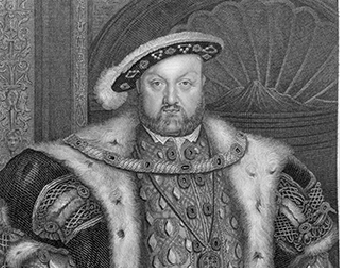Remembered as much for his wives as his politics, we delve into the life of this most complicated monarch, who is perhaps the most well-known of all the Kings of England.
“Have fun with Henry at Hampton Court Palace,” says a poster at the local train station. Fun might not be quite the word his six wives would have used but you know at once who it refers to.
King Henry VIII is the most famous monarch this country has ever had: instantly recognisable from Holbein’s portrait of him as a great fat figure, hands on hips, shoulders padded, legs wide, hat tilted over his broad, bearded face. He is Britain’s answer to Bluebeard; a monster who married six wives, divorced four and executed two on charges on adultery. He is the tyrant who caused the break with Rome and sent saintly Sir Thomas More to his untimely death.
Yet, ironically, this king who changed our history wasn’t meant to be king at all. His elder brother, Arthur, was the heir to the throne. But Arthur died aged only 15, leaving Catherine of Aragon a widow and Henry to ascend the throne when his father, King Henry VII, died on 22 April 1509.
Hampton Court Palace will forever be linked to Henry, ever since he took the pleasure palace on the banks of the Thames from his chief minister Cardinal Wolsey and rebuilt it. It was here that his third wife, Jane Seymour, gave birth to his only legitimate son, Prince Edward (later King Edward VI). She died soon afterwards.
The original owner-builder of the palace was Henry’s lord chancellor, Cardinal Wolsey, who wisely handed it over when Henry made it clear how badly he wanted it. But if the cardinal imagined he’d bought Henry’s undying support, he severely miscalculated. Four years later Wolsey was on his way to the Tower of London, while the king, with barely a backward glance, made it his principal home.
Here his son, Edward VI, was baptised. Here he divorced his fourth wife, Anne of Cleves; learned his fifth wife, Catherine Howard, was committing adultery; and married his last queen, Katherine Parr, in the Chapel Royal in 1543.
Prior to living at Hampton Court Palace, Henry had grown up at the royal palaces in Greenwich (his birthplace), Eltham Palace (which has recently been restored) and Richmond, not far from Hampton Court.
Greenwich and Richmond palaces are long gone, though Richmond museum has a model of the palace, and the park nearby still covers much of Henry’s hunting ground.
“Because he was the ‘the spare’, not the heir to the throne, Henry grew up in a household of women, with his mother and sisters, until he reached his early teens. That’s quite extraordinary for a Tudor boy,” historian Dr Starkey points out. And unlike his later image, “he was considered the ideal prince – handsome, heroic, musical, moral, athletic, amorous, virtuous, visionary. Above all, well educated and well read, in Latin.”
Henry’s own books are the core collection at the British Library. “Henry was incapable of reading a book without writing on it,”says Dr Starkey. “So we can penetrate his mind, see how his books became an information pool for the royal think-tank and helped him make his case for a divorce from Katherine of Aragon when she failed to give him a son and heir.”
There are also lesser-known places linked to King Henry VIII, such as his chain of coastal forts. Henry carefully mapped the whole coastline from Hull to Milford Haven – you can see it in the British Library – and worked out where each fort must go, to defend his shores from invasion by Catholic Europe. Dover already existed, but others, like Pendennis and St Mawes in Cornwall, Walmer in Kent, and Southsea on the Solent, were built to his Tudor-rose design.
“It was a task sensationally well done,” says Dr Starkey. Many of them did sterling service for centuries and now, preserved by English Heritage, attract thousands of visitors. English Heritage is also custodian of dozens of abbeys and religious houses ruined during Henry’s Dissolution of the Monasteries, such as Rievaulx, Byland and Fountains.
Henry was actually watching from Southsea Castle, in July 1545, when his favourite warship, the Mary Rose, sailed out to attack the French fleet – and sank. He had commissioned her as soon as he came to the throne and she’d been in service ever since.
But on that fine summer day she suddenly heeled over and went down, with almost all her 500 crew. Why? No one knows, and she stayed on the seabed till she – and hundreds of Tudor artefacts – were raised, in 1982, and housed in a ship hall in Portsmouth’s historic harbour. She is now displayed within Portsmouth’s Historic Dockyard.
Perhaps a fitting climax to a tour of Henry’s England though would be a tour of the Tower of London – not least because a few yards away is the site of Anne Boleyn’s execution.
She was buried close by in the Chapel of St Peter ad Vincula, and every year on 19 May, the day she died, an anonymous bouquet is sent to the Tower and placed on her tomb.
(Interview by Sally Varlow.)
Related articlesBook that helped Henry VIII annul his marriage |
Click here to subscribe! |
Download BRITAIN Magazine to your mobile today

 No mobile device? Purchase directly on Zinio for your desktop!
No mobile device? Purchase directly on Zinio for your desktop!






 © 2024
© 2024